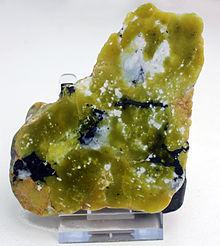
Back Lizardit Azerbaijani Lizardita Catalan Lizardit German Lizardita Basque Lizardite French ליזרדיט HE Lizardite Italian Lizardyt Polish Lizardite Portuguese Lizardit Slovenian
| Lizardite | |
|---|---|
 | |
| General | |
| Category | Mineral |
| Formula (repeating unit) | Mg3(Si2O5)(OH)4[1] |
| IMA symbol | Lz[2] |
| Strunz classification | 9.ED.15 |
| Dana classification | 71.01.2b.02 |
| Crystal system | Trigonal |
| Identification | |
| Color | Green, brown, light yellow to white |
| Mohs scale hardness | 2.5 |
| Luster | Resinous, waxy, greasy |
| Streak | White |
| Specific gravity | 2.55 |
Lizardite is a mineral from the serpentine subgroup[3] with formula Mg3(Si2O5)(OH)4, and the most common type of mineral in the subgroup.[4] It is also a member of the kaolinite-serpentine group.[5]
Lizardite may form a solid-solution series with the nickel-bearing népouite (pure end-member: Ni3(Si2O5)(OH)4). Intermediate compositions (Mg,Ni)3(Si2O5)(OH)4 are possible, with varying proportions of magnesium and nickel.[6] However, the lizardite end-member is much more common than pure népouite, a relatively rare mineral most often formed by the alteration of ultramafic rocks.
Extremely fine-grained, scaly lizardite (also called orthoantigorite) comprises much of the serpentine present in serpentine marbles. It is triclinic, has one direction of perfect cleavage, and may be white, yellow or green. Lizardite is translucent and soft, and may be pseudomorphous after enstatite, olivine or pyroxene, in which case the name bastite is sometimes applied. Bastite may have a silky lustre.[1]
- ^ a b Cite error: The named reference
:1was invoked but never defined (see the help page). - ^ Warr, L.N. (2021). "IMA–CNMNC approved mineral symbols". Mineralogical Magazine. 85 (3): 291–320. Bibcode:2021MinM...85..291W. doi:10.1180/mgm.2021.43. S2CID 235729616.
- ^ Allaby, Michael (2020-01-09). A Dictionary of Geology and Earth Sciences. Oxford University Press. ISBN 978-0-19-257570-8.
- ^ "Lizardite gemstone information". www.gemdat.org. Retrieved 2021-10-26.
- ^ Gaines, Richard V.; Skinner, H. Catherine W.; Foord, Eugene E.; Mason, Brian; Rosensweig, Abraham (1997). Dana's new mineralogy : the system of mineralogy of James Dwight Dana and Edward Salisbury Dana (8th, entirely rewritten and greatly enl. ed.). New York: Wiley. ISBN 978-0471193104.
- ^ Brindley, G.W.; Wan, Hsien-Ming (1975). "Compositions, structures, and thermal behavior of nickel-containing minerals in the lizardite-nepouite series". American Mineralogist. 60: 863–871. Retrieved 3 November 2021.